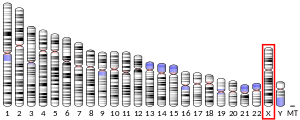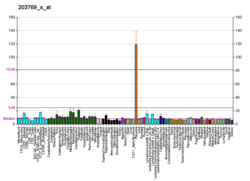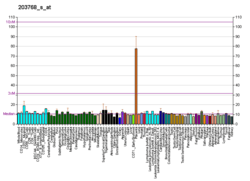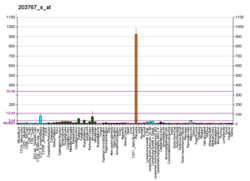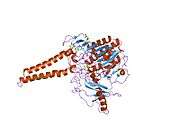Steroid sulfatase
Steroid sulfatase (STS), or steryl-sulfatase (EC 3.1.6.2), formerly known as arylsulfatase C, is a sulfatase enzyme involved in the metabolism of steroids. It is encoded by the STS gene.[3]
| Steryl-sulfatase | |||||||||
|---|---|---|---|---|---|---|---|---|---|
| Identifiers | |||||||||
| EC number | 3.1.6.2 | ||||||||
| CAS number | 9025-62-1 | ||||||||
| Databases | |||||||||
| IntEnz | IntEnz view | ||||||||
| BRENDA | BRENDA entry | ||||||||
| ExPASy | NiceZyme view | ||||||||
| KEGG | KEGG entry | ||||||||
| MetaCyc | metabolic pathway | ||||||||
| PRIAM | profile | ||||||||
| PDB structures | RCSB PDB PDBe PDBsum | ||||||||
| |||||||||
Reactions
This enzyme catalyses the following chemical reaction
- 3β-hydroxyandrost-5-en-17-one 3-sulfate + H2O 3β-hydroxyandrost-5-en-17-one + sulfate
Also acts on some related steryl sulfates.
Function
The protein encoded by this gene catalyzes the conversion of sulfated steroid precursors to the free steroid. This includes DHEA sulfate, estrone sulfate, pregnenolone sulfate, and cholesterol sulfate, all to their unconjugated forms (DHEA, estrone, pregnenolone, and cholesterol, respectively).[4][5] The encoded protein is found in the endoplasmic reticulum, where it is present as a homodimer.[3]
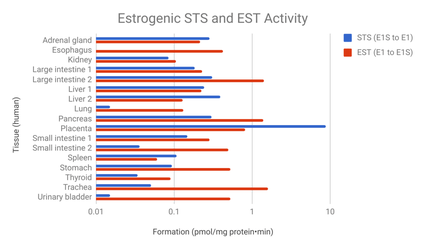
Clinical significance
A congenital deficiency in the enzyme is associated with X-linked ichthyosis, a scaly-skin disease affecting roughly 1 in every 2,000 to 6,000 males.[7][8] The excessive skin scaling or hyperkeratosis is caused by a lack of breakdown and thus accumulation of cholesterol sulfate, a steroid that stabilizes cell membranes and adds cohesion, in the outer layers of the skin.[4]
Steroid sulfates like DHEA sulfate and estrone sulfate serve as large biologically inert reservoirs for conversion into androgens and estrogens, respectively, and hence are of significance for androgen- and estrogen-dependent conditions like prostate cancer, breast cancer, endometriosis, and others. A number of clinical trials have been performed with inhibitors of the enzyme that have demonstrated clinical benefit, particularly in oncology and so far up to Phase II.[9] The non-steroidal drug Irosustat has been the most studied to date.
Inhibitors
Inhibitors of STS include irosustat, estrone sulfamate (EMATE), estradiol sulfamate (E2MATE), and danazol.[10][11] The most potent inhibitors are based around the aryl sulfamate pharmacophore[12] and it is thought that such compounds irreversibly modify the active site formylglycine residue of steroid sulfatase.[9]
Names
Steryl-sulfatase is also known as arylsulfatase, steroid sulfatase, sterol sulfatase, dehydroepiandrosterone sulfate sulfatase, arylsulfatase C, steroid 3-sulfatase, steroid sulfate sulfohydrolase, dehydroepiandrosterone sulfatase, pregnenolone sulfatase, phenolic steroid sulfatase, 3-beta-hydroxysteroid sulfate sulfatase, as well as by its systematic name steryl-sulfate sulfohydrolase.[13][14][15]
See also
- Steroidogenic enzyme
- Steroid sulfotransferase
- Estrogen sulfotransferase
References
- GRCh38: Ensembl release 89: ENSG00000101846 - Ensembl, May 2017
- "Human PubMed Reference:". National Center for Biotechnology Information, U.S. National Library of Medicine.
- "Entrez Gene: STS steroid sulfatase (microsomal), arylsulfatase C, isozyme S".
- Mueller JW, Gilligan LC, Idkowiak J, Arlt W, Foster PA (October 2015). "The Regulation of Steroid Action by Sulfation and Desulfation". Endocrine Reviews. 36 (5): 526–63. doi:10.1210/er.2015-1036. PMC 4591525. PMID 26213785.
- Rižner TL (2016). "The Important Roles of Steroid Sulfatase and Sulfotransferases in Gynecological Diseases". Frontiers in Pharmacology. 7: 30. doi:10.3389/fphar.2016.00030. PMC 4757672. PMID 26924986.
- Miki Y, Nakata T, Suzuki T, Darnel AD, Moriya T, Kaneko C, et al. (December 2002). "Systemic distribution of steroid sulfatase and estrogen sulfotransferase in human adult and fetal tissues". The Journal of Clinical Endocrinology and Metabolism. 87 (12): 5760–8. doi:10.1210/jc.2002-020670. PMID 12466383.
- Alperin ES, Shapiro LJ (August 1997). "Characterization of point mutations in patients with X-linked ichthyosis. Effects on the structure and function of the steroid sulfatase protein". The Journal of Biological Chemistry. 272 (33): 20756–63. doi:10.1074/jbc.272.33.20756. PMID 9252398.
- Ghosh D (December 2004). "Mutations in X-linked ichthyosis disrupt the active site structure of estrone/DHEA sulfatase". Biochimica et Biophysica Acta (BBA) - Molecular Basis of Disease. 1739 (1): 1–4. doi:10.1016/j.bbadis.2004.09.003. PMID 15607112.
- Potter BV (August 2018). "SULFATION PATHWAYS: Steroid sulphatase inhibition via aryl sulphamates: clinical progress, mechanism and future prospects". Journal of Molecular Endocrinology. 61 (2): T233–T252. doi:10.1530/JME-18-0045. PMID 29618488.
- Thomas MP, Potter BV (September 2015). "Estrogen O-sulfamates and their analogues: Clinical steroid sulfatase inhibitors with broad potential". The Journal of Steroid Biochemistry and Molecular Biology. 153: 160–9. doi:10.1016/j.jsbmb.2015.03.012. PMID 25843211. S2CID 24116740.
- Carlström K, Döberl A, Pousette A, Rannevik G, Wilking N (1984). "Inhibition of steroid sulfatase activity by danazol". Acta Obstetricia Et Gynecologica Scandinavica. Supplement. 123: 107–11. doi:10.3109/00016348409156994. PMID 6238495.
- Thomas MP, Potter BV (October 2015). "Discovery and Development of the Aryl O-Sulfamate Pharmacophore for Oncology and Women's Health". Journal of Medicinal Chemistry. 58 (19): 7634–58. doi:10.1021/acs.jmedchem.5b00386. PMC 5159624. PMID 25992880.
- Roy AB (October 1954). "The steroid sulphatase of Patella vulgata". Biochimica et Biophysica Acta. 15 (2): 300–1. doi:10.1016/0006-3002(54)90078-5. PMC 1274509. PMID 13208702.
- Roy AB (1960). The synthesis and hydrolysis of sulfate esters. Advances in Enzymology and Related Subjects of Biochemistry. Advances in Enzymology - and Related Areas of Molecular Biology. 22. pp. 205–35. doi:10.1002/9780470122679.ch5. ISBN 9780470122679. PMID 13744184.
- Halkerston ID, Hillman J, Stitch SR (August 1956). "The enzymic hydrolysis of steroid conjugates. I. Sulphatase and beta-glucuronidase activity of molluscan extracts". The Biochemical Journal. 63 (4): 705–10. doi:10.1042/bj0630705. PMC 1216242. PMID 13355874.
Further reading
- Elias PM, Crumrine D, Rassner U, Hachem JP, Menon GK, Man W, et al. (February 2004). "Basis for abnormal desquamation and permeability barrier dysfunction in RXLI". The Journal of Investigative Dermatology. 122 (2): 314–9. doi:10.1046/j.1523-1747.2003.22258.x. PMID 15009711.
- Basler E, Grompe M, Parenti G, Yates J, Ballabio A (March 1992). "Identification of point mutations in the steroid sulfatase gene of three patients with X-linked ichthyosis". American Journal of Human Genetics. 50 (3): 483–91. PMC 1684279. PMID 1539590.
- Shankaran R, Ameen M, Daniel WL, Davidson RG, Chang PL (June 1991). "Characterization of arylsulfatase C isozymes from human liver and placenta". Biochimica et Biophysica Acta (BBA) - Protein Structure and Molecular Enzymology. 1078 (2): 251–7. doi:10.1016/0167-4838(91)90566-I. PMID 2065092.
- Stein C, Hille A, Seidel J, Rijnbout S, Waheed A, Schmidt B, et al. (August 1989). "Cloning and expression of human steroid-sulfatase. Membrane topology, glycosylation, and subcellular distribution in BHK-21 cells". The Journal of Biological Chemistry. 264 (23): 13865–72. PMID 2668275.
- Kawano J, Kotani T, Ohtaki S, Minamino N, Matsuo H, Oinuma T, Aikawa E (August 1989). "Characterization of rat and human steroid sulfatases". Biochimica et Biophysica Acta (BBA) - Protein Structure and Molecular Enzymology. 997 (3): 199–205. doi:10.1016/0167-4838(89)90187-8. PMID 2765556.
- Yen PH, Allen E, Marsh B, Mohandas T, Wang N, Taggart RT, Shapiro LJ (May 1987). "Cloning and expression of steroid sulfatase cDNA and the frequent occurrence of deletions in STS deficiency: implications for X-Y interchange". Cell. 49 (4): 443–54. doi:10.1016/0092-8674(87)90447-8. PMID 3032454. S2CID 23353934.
- Conary JT, Lorkowski G, Schmidt B, Pohlmann R, Nagel G, Meyer HE, et al. (April 1987). "Genetic heterogeneity of steroid sulfatase deficiency revealed with cDNA for human steroid sulfatase". Biochemical and Biophysical Research Communications. 144 (2): 1010–7. doi:10.1016/S0006-291X(87)80064-5. PMID 3034252.
- Ballabio A, Parenti G, Carrozzo R, Coppa G, Felici L, Migliori V, et al. (July 1988). "X/Y translocation in a family with X-linked ichthyosis, chondrodysplasia punctata, and mental retardation: DNA analysis reveals deletion of the steroid sulphatase gene and translocation of its Y pseudogene". Clinical Genetics. 34 (1): 31–7. doi:10.1111/j.1399-0004.1988.tb02612.x. PMID 3165728.
- Yen PH, Marsh B, Allen E, Tsai SP, Ellison J, Connolly L, et al. (December 1988). "The human X-linked steroid sulfatase gene and a Y-encoded pseudogene: evidence for an inversion of the Y chromosome during primate evolution". Cell. 55 (6): 1123–35. doi:10.1016/0092-8674(88)90257-7. PMID 3203382. S2CID 42065481.
- Chang PL, Varey PA, Rosa NE, Ameen M, Davidson RG (November 1986). "Association of steroid sulfatase with one of the arylsulfatase C isozymes in human fibroblasts". The Journal of Biological Chemistry. 261 (31): 14443–7. PMID 3464600.
- Munroe DG, Chang PL (February 1987). "Tissue-specific expression of human arylsulfatase-C isozymes and steroid sulfatase". American Journal of Human Genetics. 40 (2): 102–14. PMC 1684069. PMID 3471087.
- Müller CR, Wahlström J, Ropers HH (1982). "Further evidence for the assignment of the steroid sulfatase X-linked ichthyosis locus to the telomer of Xp". Human Genetics. 58 (4): 446–447. doi:10.1007/bf00282842. PMID 6948769. S2CID 23372914.
- Migeon BR, Shapiro LJ, Norum RA, Mohandas T, Axelman J, Dabora RL (October 1982). "Differential expression of steroid sulphatase locus on active and inactive human X chromosome". Nature. 299 (5886): 838–40. Bibcode:1982Natur.299..838M. doi:10.1038/299838a0. PMID 6957717. S2CID 4361097.
- Bonaldo MF, Lennon G, Soares MB (September 1996). "Normalization and subtraction: two approaches to facilitate gene discovery". Genome Research. 6 (9): 791–806. doi:10.1101/gr.6.9.791. PMID 8889548.
- Alperin ES, Shapiro LJ (August 1997). "Characterization of point mutations in patients with X-linked ichthyosis. Effects on the structure and function of the steroid sulfatase protein". The Journal of Biological Chemistry. 272 (33): 20756–63. doi:10.1074/jbc.272.33.20756. PMID 9252398.
- Sugawara T, Shimizu H, Hoshi N, Fujimoto Y, Nakajima A, Fujimoto S (March 2000). "PCR diagnosis of X-linked ichthyosis: identification of a novel mutation (E560P) of the steroid sulfatase gene". Human Mutation. 15 (3): 296. doi:10.1002/(SICI)1098-1004(200003)15:3<296::AID-HUMU17>3.0.CO;2-#. PMID 10679952.
- Oyama N, Satoh M, Iwatsuki K, Kaneko F (June 2000). "Novel point mutations in the steroid sulfatase gene in patients with X-linked ichthyosis: transfection analysis using the mutated genes". The Journal of Investigative Dermatology. 114 (6): 1195–9. doi:10.1046/j.1523-1747.2000.00004.x. PMID 10844566.
- Jimenez Vaca AL, Valdes-Flores M, Rivera-Vega MR, González-Huerta LM, Kofman-Alfaro SH, Cuevas-Covarrubias SA (December 2001). "Deletion pattern of the STS gene in X-linked ichthyosis in a Mexican population". Molecular Medicine. 7 (12): 845–9. doi:10.1007/BF03401976. PMC 1950010. PMID 11844872.
- Hoffmann R, Rot A, Niiyama S, Billich A (December 2001). "Steroid sulfatase in the human hair follicle concentrates in the dermal papilla". The Journal of Investigative Dermatology. 117 (6): 1342–8. doi:10.1046/j.0022-202x.2001.01547.x. PMID 11886493.
- Matsuoka R, Yanaihara A, Saito H, Furusawa Y, Toma Y, Shimizu Y, et al. (June 2002). "Regulation of estrogen activity in human endometrium: effect of IL-1beta on steroid sulfatase activity in human endometrial stromal cells". Steroids. 67 (7): 655–9. doi:10.1016/S0039-128X(02)00016-8. PMID 11996939. S2CID 11872655.
External links
- Steryl-Sulfatase at the US National Library of Medicine Medical Subject Headings (MeSH)

